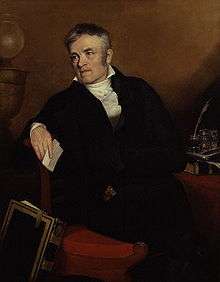Rudolph Ackermann

Rudolph Ackermann (20 April 1764 in Schneeberg, Electorate of Saxony – 30 March 1834 in Finchley, London)[1] was an Anglo-German bookseller, inventor, lithographer, publisher and businessman.
Biography
He attended the Latin school in Stollberg, but his wish to study at the university was made impossible by lack of financial means, and he therefore became a saddler like his father.

He worked as a saddler and coach-builder in different German cities, moved from Dresden to Basel and Paris, and then, 23 years old, settled in London. He established himself in Long Acre, the centre of coach-making in London and close to the market at Covent Garden. His extraordinary business instinct, as well as his flair for design and talent for self-promotion, won him the £200 contract to design the ceremonial coach for the Lord Chancellor of Ireland, John FitzGibbon, 1st Earl of Clare. After this he designed The Royal Sailor, an 8-wheel omnibus that ran between Charing Cross, Greenwich and Woolwich.[2]
Ackermann then moved to Little Russell Street where he published Imitations of Drawings of Fashionable Carriages (1791) to promote his coach-making. Other publications followed. In 1795 he established a print-shop and drawing-school at 96 Strand.[3] Ackermann set up a lithographic press[1] and began a trade in prints. He later began to manufacture colours and thick carton paper for landscape and miniature painters. Within three years the premises had become too small and he moved to 101 Strand, in his own words "four doors nearer to Somerset House", the seat of the Royal Academy of Arts.[2]
In 1809 he applied his press to the illustration of his Repository of Arts, Literature, Fashions, which appeared monthly until 1829, when forty volumes had appeared. Thomas Rowlandson and other distinguished artists were regular contributors. Repository documented the changing classicising fashions in dress and furniture of the Regency. He also introduced the fashion of the once popular Literary Annuals, beginning in 1823 with Forget-Me-Not; and he published many illustrated volumes of topography and travel, including The Microcosm of London (3 volumes, 1808–1811), Westminster Abbey (2 volumes, 1812), The Rhine (1820) and The World in Miniature (43 volumes, 1821–1826).[1]
In 1801 he patented a method for rendering paper and cloth waterproof and erected a factory in Chelsea to make it [4]. He was one of the first to illuminate his own premises with gas. Indeed, the introduction of lighting by gas owed much to him.[1] After the Battle of Leipzig, Ackermann collected nearly a quarter of a million pounds sterling for the German casualties.[1] He also patented the Ackermann steering geometry.[5] He was buried at St. Clement Danes in The Strand, London.
See also
References
- 1 2 3 4 5

- 1 2 James Hamilton (2014), A Strange Business: Making Art and Money in Nineteenth-Century Britain. Atlantic Books. ISBN 9781848879249.
- ↑ Chambers Biographical Dictionary, ISBN 0-550-18022-2, page 6
- ↑ Maxted, Ian (1977). The London Book Trades1775-1780. Folkstone, England: Dawson. p. 1. ISBN 0-7129-0696-7.
- ↑ King-Hele, Desmond (2002). "ERASMUS DARWIN'S IMPROVED DESIGN FOR STEERING CARRIAGES—AND CARS". Notes and Records. 56 (1): 41–62.
- Allgemeine Deutsche Biographie – online version at Wikisource
- Catalogue of Political and Personal Satires Preserved in the Department of Prints and Drawings in the British Museum, Mary Dorothy George. Vol VI 1938, Vol VII, 1942 VOL VIII 1947, VOL IX 1949
Further reading
- Rudolph Ackermann (1808), Microcosm of London, Illustrated by Augustus Charles Pugin and Thomas Rowlandson . 1904 reprint + Illustrations
- Martin Hardie (1906), English Coloured Books, London: Methuen & Co and New York: G.P. Putnam's & Sons. Chapter X: Rudolph Ackermann. (pp. 96–116; with index of works, pp. 310–314).
- S.T. Prideaux (1909), Aquatint engraving. London: Duckworth & Co. Chapter VI: Rudolph Ackermann and his Associates. (pp. 110–152; with index of works, pp. 374–378)
External links
![]()
- Forget Me Not: A Hypertextual Archive of Ackermann's 19th-Century Literary Annual reproduces elements from the 1823–1830 volumes of the earliest British-published literary annual, Forget Me Not, published by Rudolf Ackermann between 1823 and 1847. Hyperlinks allow the volumes to be examined by author, engraver, etc., and include references to other works submitted to similar 19th century literary journals.